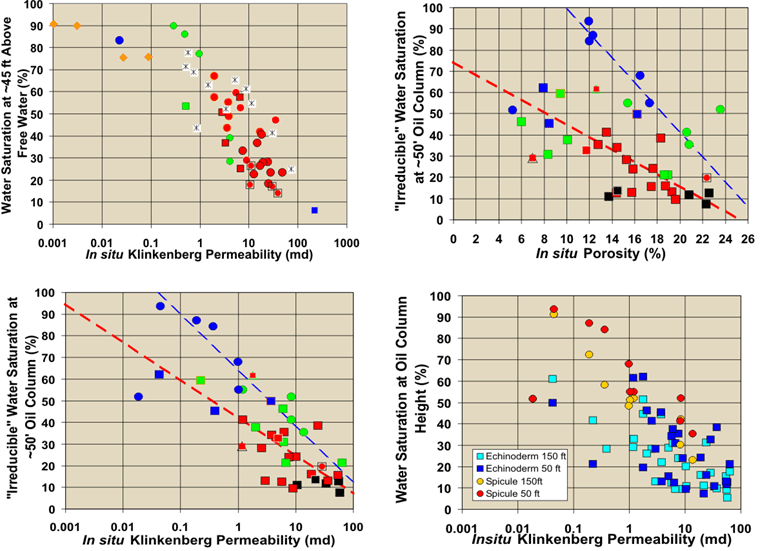Capillary Pressure
Capillary pressure properties of Mississippian carbonates differ between lithofacies. Structural closure in many Mississippian Kansas fields is less than 60 feet limiting oil column heights thereby necessitating an understanding of the exact capillary pressure relationships.
Air-brine capillary pressure measurements indicate that water saturations at 45-50 ft (Sw45,Sw50) above free water increase with decreasing porosity and permeability (Figures). Because of the close correlation between lithofacies and permeability-porosity, Sw also increase with decreasing grain/mold size from packstone to mudstone. Sw45 in Schaben can be predicted within + 14% (saturation %) using:
Sw45(%) = -20*log kinsitu + 61
The echinoderm-rich facies in Ness Field, Sw50 is correlated
with ![]() and k but exhibits
very different relations between the spicule-rich and the echinoderm-rich
facies:
and k but exhibits
very different relations between the spicule-rich and the echinoderm-rich
facies:
Sw50(%) = -3.21
insitu + 87.6 All (SE=19%)
Sw50(%) = -2.95insitu + 74.5 Echinoderm (SE=9.3)
Sw50(%) = -5.76insitu+ 156.4 Spicule (SE=6.7)
Sw50(%) = -17.5 log10 kinsitu + 42.1 Echinoderm (SE=8.7)
Sw50(%) = -25.5 log10 kinsitu + 63.8 Spicule (SE=6.6)
Sw-![]() and Sw-k crossplots
reveal how subtle changes in lithology can affect saturations. Increase in
mud and spicule content elevates Sw in the echinoderm pack-wackestones. Increase
in dense chert content decreases porosity without changing Sw. Changes in
Sw between 50 and 150 feet in oil column height are small for spicule-rich
facies indicating they are at “irreducible” Sw at 50 feet. Echinoderm-rich
facies have low saturations, additional capillary pressure continues to decrease
Sw.
and Sw-k crossplots
reveal how subtle changes in lithology can affect saturations. Increase in
mud and spicule content elevates Sw in the echinoderm pack-wackestones. Increase
in dense chert content decreases porosity without changing Sw. Changes in
Sw between 50 and 150 feet in oil column height are small for spicule-rich
facies indicating they are at “irreducible” Sw at 50 feet. Echinoderm-rich
facies have low saturations, additional capillary pressure continues to decrease
Sw.

|
|
e-mail : webadmin@kgs.ku.edu
Last updated May 2003
http://www.kgs.ku.edu/PRS/publication/2003/ofr2003-32/P2-09.html
